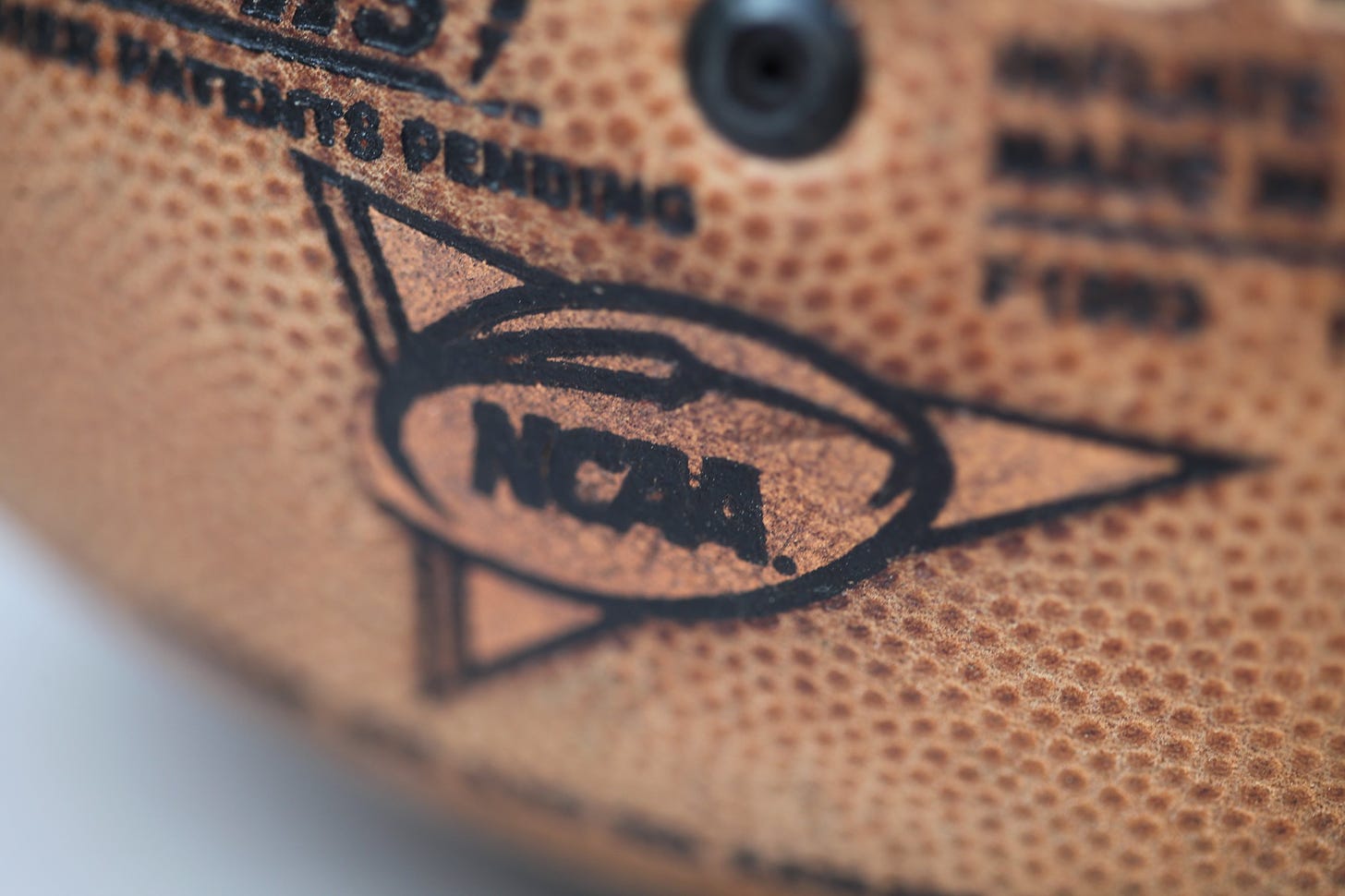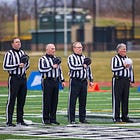The case that can kill amateurism - and the NCAA
Let's deep dive into House v. NCAA and how it will reshape the college athletics landscape

The NCAA has a laundry list of cases pending against it. Most likely won’t reach the courts, including this one. But does a case have enough behind it to completely change the face of college sports forever? And can a collection of cases make amateurism an anachronism? Let’s get into House v. NCAA and why it not making it to court will have a bigger impact than it could in front of a judge.
What is House v. NCAA?
House v. NCAA is a lawsuit brought against the NCAA in 2020 by former Arizona State swimmer Grant House. It’s a case that we’ve discussed before, but we’ll go over it again in detail for those new to the newsletter or just need a refresher. If you’re familiar with the case, you can skip this section.
The House case, in essence, is challenging the NCAA’s previous NIL rules under the Sherman Act. Plaintiffs are claiming that the NCAA limited their ability to engage in the free market with their name, image and likeness rights, which prohibited student-athletes from earning potential revenue through endorsement deals, video games and more. House, in particular, turned its attention to TV deals and social media. The athletes are the ones creating the product on TV and social media, and they deserve to share in that revenue, according to the case’s plaintiffs
After the case was filed, the NCAA in 2021 filed a motion to dismiss it. In their motion to dismiss, the NCAA claimed that prohibiting athletes from earning any compensation was a major cornerstone of the product and their stringent NIL rules were “necessary to preserve consumer demand for college sports as a distinct product.” They also claimed that any pro-competitive action, which would be allowing NIL compensation in this case, would remove them from the market of amateur sports and should be excluded from Rule of Reason analysis with the Sherman Act.
Obviously, we know that the idea that amateurism is necessary for college sports to succeed is blatantly incorrect. NIL has been adopted and, while it has brought some problems for teams, players and fans, college sports have succeeded. Women’s sports, particularly basketball and volleyball, are smashing past their previous viewership records. The College Football Playoff also scored record viewership by ESPN’s metrics. Even with players finally earning their worth, the fans are still flocking to college sports.
The NCAA’s motion to dismiss the House case was denied and the case proceeded onward.
In late 2023, federal judge Claudia Wilken granted class-action status to House v. NCAA. This change in status allows other cases to join in on House, increasing the number of plaintiffs and potential payouts that the NCAA would have to pay if they were to lose the case. According to Sport Business Journal, the plaintiffs in House were seeking around $1.4 billion from the NCAA and conferences. However, antitrust cases can often balloon once they are decided in court, with an estimated award to the plaintiffs of $4.2 billion if the NCAA was to lose the court battle.
With the ruling by Wilkens and the way the suit is constructed, a ruling or settlement in House could potentially impact over 14,000 current and former student-athletes.
Where are we today?
Currently, House v. NCAA is slated to be heard in January 2025, so pressure is starting to mount on the NCAA, conferences and member schools to get out of this situation. There was no surprise when ESPN’s Pete Thamel and Dan Murphy reported that the NCAA and college sports leaders were engaged in deep conversations on settling the case in late April.
Since the case gained class-action status, a settlement was seen as the most likely option. With the NCAA constantly receiving blow after blow from their court cases, first in Alston v. NCAA (2021) and the various injunctions that have shot down any attempts by the NCAA of regulating NIL and the transfer portal, staying out of court is an appealing option. Especially with billions of dollars and their very existance on the line.
According to Thamel and Murphy, leaders across the NCAA and its member schools are exploring a “multi-billion dollar settlement,” with the plaintiffs.
How does a settlement benefit the NCAA?
We’ll focus a lot on how these options benefit the NCAA because, in all honestly, the ball is in their court. The plaintiffs have a solid case that has a real shot of holding up and defeating the NCAA in court, so it’s up to the NCAA to decide what they believe is the best path forward.
With that said, let’s focus on what a settlement would look like and how it would affect the NCAA and its member institutions.
According to Yahoo! Sports’s Ross Dellenger, a settlement in House would have to address to main points of the case: (1) the compensation owed to athletes for the schools’ previous usage of their NIL rights in television broadcasts and social media, and (2) compensation for future use of student-athletes’ NIL rights in television broadcasts and social media.
The former is easier to handle. That will be the multi-billion dollar settlement that Thamel and Murphy floated in their reporting. The latter is where things get interesting.
By agreeing to a settlement, the NCAA would be admitting that their prior NIL rules were too restrictive and that athletes are due payment from future television deals. That opens up a new can of worms: revenue sharing.
It’s how most professional sports generate most of their profit to pay athletes, and it could soon be coming to college athletics. This would be a seismic change, and while Power Five conferences - including the now mostly defunct PAC-12 - this would affect all of college sports. According to Dellenger, schools would likely have to put $15-20 million annually from their television and social media revenue towards athlete revenue sharing. This would also potentially introduce a salary cap, killing any facade of amateurism left in the NCAA.
What if it goes to court? Are there any benefits to the NCAA?
I actually think the NCAA is in an even worse spot if House gets to court.
First, the potential damages astronomically increase. We don’t know how close the discussed settlement is to the $4.2 billion that a loss in court could force the NCAA to pony up, but we can assume an extra billion on top would cripple some schools.
Secondly, the NCAA has an uphill battle to fight in court. This starts with the woman on the bench, Wilken. She’s already shot down the NCAA’s attempts to dismiss the case and prohibit a class-action status. She also ruled against the NCAA previously in both Alston (2021) and O’Bannon (2013), the two most recent court cases that have plunged the NCAA into disarray.
So, say this goes to court and Wilken sides with the plaintiffs and awards them over $4 billion in damages. The NCAA would appeal, right?
That likely won’t go well. The Supreme Court already took aim at the NCAA in their 2021 Alston decision. All you need to know about that is Justice Brett Kavanaugh’s poignant words:
“Nowhere else in America can businesses get away with agreeing not to pay their workers a fair market rate on the theory that their product is defined by not paying their workers a fair market rate. And under ordinary principles of antitrust law, it is not evident why college sports should be any different. The NCAA is not above the law."
Even if the NCAA is able to weather the storm in House, they would still face heavy hitting cases in Hubbard v. NCAA and Carter v. NCAA. All three cases have been brought and are being led by attorney Jeffrey Kessler, so he would learn from his mistakes in House to make the NCAA pay later.
Hubbard is seeking to backpay Alston payments that prior athletes would have been eligible for. It is currently seeking class-action status and will be heard by our friend Judge Wilken. Carter is seeking to award athletes with their value if schools were not limited on recruiting spending, alleging the NCAA is limiting the recruiting market. Carter is also seeking class-action status and is filed in the same district as the others, but will be on the desk of Judge Donna Ryu. As another point for a settlement, perhaps the NCAA and its member schools could settle all three at the same time since they’re dealing with Kessler already.
This is going to kill the NCAA, right?
I won’t say that’s a certaintly, but certainly a possibility.
We’ve already seen building tension between the member schools and the NCAA. The Big 10 and SEC are forming a “joint advisory group” to explore life after the NCAA. Both commissioners, Tony Petiti and Greg Sankey, said that this is not about breaking off from the College Football Playoff, and is instead about chartering the right path forward. But could they, with most of the biggest brands in college sports, survive on their own without the NCAA? They have the best chance.
Other groups outside college athletics have looked at a post-NCAA governance with direct athlete compensation, like the Coalition for the Future of College Athletics and College Sports Tomorrow.
Required Reading:
There’s also a push from some Republican representatives to cement the current NCAA amateurism policies in law with the Protect the Benefits for Athletes and Limit Liability, or Protect the BALL Act. The bill, introduced May 8 by Russell Fry (R-SC) and Barry Moore (R-AL) faces an uphill climb, but shows that there is a pro-NCAA and amateurism faction still brewing.
But with NCAA president Charlie Baker himself discussing the possibility of direct athlete compensation, it seems like the death kneel for amateurism is the outcome of House. Whether it also heralds the end for the NCAA is yet to be seen.
Have any questions, ideas, article pitches, or information? With the new Substack features, you can directly message me! Hit the button below to send me a message, or reach out via email to sidsports23@gmail.com, or find us on your favorite social media platform like Facebook, Instagram, Twitter, Substack Notes and Bluesky.







